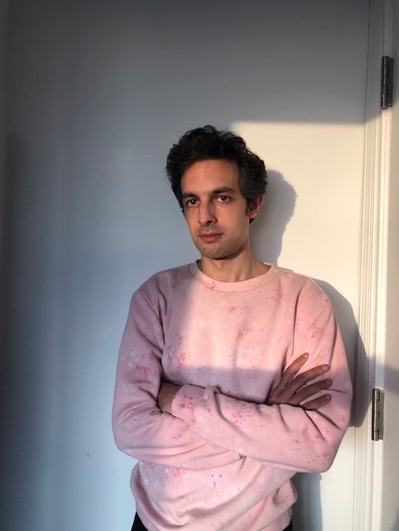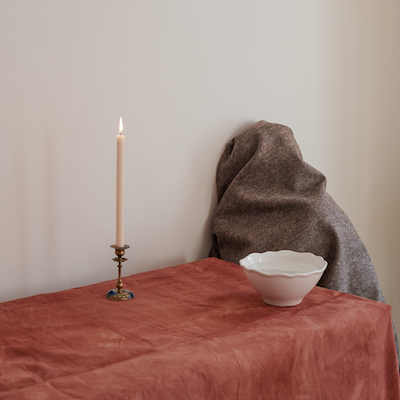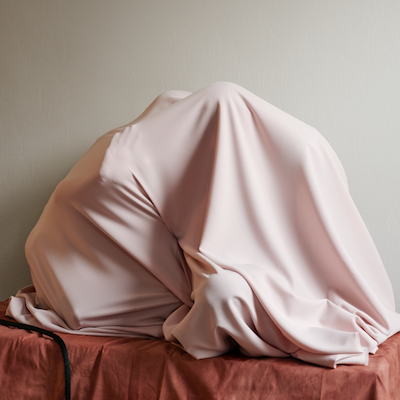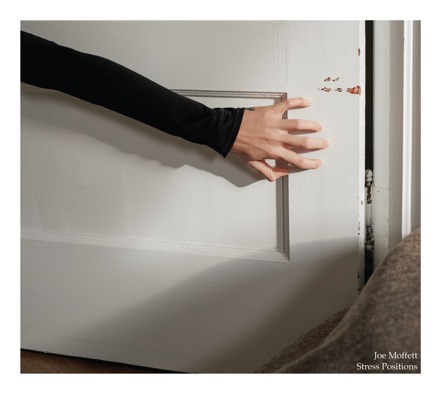Carlo Costa: Can you talk about your solo trumpet playing? When did you first start playing solo and what brought you to it?
Joe Moffett: Performing solo didn’t become a serious focus for me until around 2015. I was asked to play a set at FONT [Festival of New Trumpet Music] that year.
CC: I was there, actually.

CC: I remember it being kind of performative. I think you played two pieces, and in one of them you played with a large piece of sheet metal and were hiding behind it.
JM: Yeah, I was kneeling on the grungy concrete floor of Downtown Music Gallery in that piece. I was being a little bit of a pain in the ass -- I didn’t want to do a straight-up trumpet set. The sheet metal thing was fun because the material mirrors the actual instrument, and so I was playing with the idea of metal-against-metal, getting a raw form of metal to interact with a refined one. Because it happened live, I was able to make the set more about the event of the performance, rather than a completely aural experience.
CC: I often sense that in your solo playing there is a performative aspect, even if it’s subtle, or something that goes beyond just the sound.
JM: When you say performative, what does that mean to you?
CC: It means that there’s something visual, that you make certain choices that are informed by what it looks like, or at least you are aware of that in addition to the sound that you’re producing. In certain contexts I’ve noticed that you’re opening a window into another world a little bit, where it goes from being a concert to a performance art event, without going fully in that direction. There seems to be this subtle line that you’re straddling.
JM: That’s nice to hear, actually [laughs]. I’m not trained as a performance artist, as a modern or contemporary art practice. Though it’s interesting because in talking about “performance art” as a genre, depending who the artist is, they are not always coming from a visual art background. Vito Acconci is an example of someone who was an early performance artist, and he was a poet first. So when I’m doing what I’m doing, I’m still coming to it as a musician, and I hope it doesn’t overtly appear like I’m trying to be a performance artist, because I’m not one.
CC: No, it never is overt. I tend to not always enjoy the performative aspect in concerts -- it can be cool but sometimes it takes over the music or involves comedy to a degree. In your case, there’s a certain element of awareness. I feel like you’re aware of the absurdity of certain aspects of our music. Watching you perform is a reminder of that side of things and how it appears. In our musical circles, we take a lot for granted. If someone is spitting in a mouthpiece for ten minutes everyone is totally fine with it, but it’s pretty crazy if you think about it. Your performances seem to comment on that.
JM: It sounds like it comes across positively for you, which is good, because I don’t want to be self-serious or smug in my performances. I am aware that what I’m doing is very refined and niche, sonically. I love to make this kind of music, and I know there is an audience for it, but it is a relatively small world, and so I’m trying to open up the experience of it just a little bit, even if just for myself.
One thing I am very serious about is that I want a performance of mine truly to be a performance, an event that cannot happen in another context. I want the atmosphere to change when a performance begins. I try to be aware of my surroundings and of the circumstance, and of how I am affecting or activating both.
CC: How do you feel about recording versus performance? Do you feel that it is totally separate or just another side of the same thing?
JM: My process for this album was pretty different from other recordings of mine because I recorded it at home. I had a pretty simple recording setup in my apartment, and I could dip into the project whenever I wanted to. So on the one hand, I did not have the most sophisticated equipment nor a vast array of microphones at my disposal, but on the other I could take my time with the project and felt no pressure to get everything done in a day or two. It allowed me a lot more freedom and time to dedicate to each piece - maybe I ought to record this way more often.

I wanted to ask you, how much do you think the experience changes for the audience when they are able to see the objects that are being used by the musicians - particularly non-standard objects that are not usually considered part of the primary instrument? You use a vast array of objects to realize your sound, and I wonder how you think the ability for people to identify the objects, as in a live situation, makes it different from an audio recording, in which the instruments are concealed visually. I also wonder how much audience members get hung up on the use of individual objects and miss the overall picture as a result.
CC: That is out of our control to some degree, unless you are using an object in a way that’s meant to be theatrical. In the previous example we discussed, the performance in which you hid behind a piece of sheet metal, there was an obvious visual element to it. But generally speaking, you don’t usually do that, or there might be a brief moment in a piece where you drop something. For example, I remember you unrolling a piece of sheet metal onto the floor at an Earth Tongues concert. But that had both a visual function and a sonic one.
JM: In talking about the visual and sonic in these instances, I think of them as merging in the event, whether it is the unfurling of a scroll of metal or the action of rubbing a rubber mallet against a bass drum head to get a continuous sound. People see those things happening in a performance and understand what action is producing which sound. For me, in the best-case scenario, those actions do not exist on a binary - primarily sonic or primarily visual - but occur as one thing, as a single and singular action. They are truly temporal and not something you can freeze and split in two. This is perhaps the most powerful aspect of these kinds of performances.
CC: So as for the recording, is the objective of it a freezing or photographing of a moment in your development as a musician or in the development of a certain project, or is it just another place to experiment? Do you approach it as a completely different scenario from a live performance or somewhere in between?
JM: It is somewhere in between. The pieces I’ve recorded for this album I had been working on in some capacity for a while, and had I been doing live shows, I would have used the same or similar techniques. There is definite overlap between the recording and live performances. But one of the things I really like about albums is the commodity of them. I like the whole item: the artwork, packaging, etc. When I’m making an album, I think of it as a way to consolidate ideas into one, concise statement. So it’s not a snapshot of something that would happen in a live setting so much as a sublimation of those ideas that might be expressed live.
CC: I like the idea of a recording as a consolidation. It often feels that way for me as well, particularly for my solo work - taking these things I’ve been working on and putting them into a concise, presentable format.
JM: Albums are an opportunity to bring various elements of work into once place; it’s like a location that people can visit and revisit.
CC: You mentioned Samuel Beckett, which is interesting because in Sean [Ali]’s interview, we also discuss Beckett at length. What exactly inspires you about his work, or how do you draw from it and how does it relate to you?
JM: His work has been in my brain for a long time. The attitude and outlook on life that his works have are familiar in some way despite the oddity and even harrowing nature of the characters and situations he presents. But his work is very funny, too.
CC: There is that duality there.
JM: I think about the character Watt and how in one section of the book he moves among different pieces of furniture, exhausting every possible combination of route between them, and how these null gestures take place in the work despite their absurdity. The attitude has stuck with me, and has become especially pronounced due to the events of the past year. The day-to-day has been bleak in a repetitive way, with nothing to do but continue on. In terms of music, there is repetition in my pieces, for example taking one specific technique (like the use of false fingerings) and gaming out its use as far as possible.
CC: I can see the parallel.
JM: I recorded the album at home pretty much during the height of the first wave of the pandemic in New York, and so the circumstances of the recording did involve a feeling of futurelessness and timelessness, and so while the album is not “about” the pandemic, it certainly was created in and has the residue of that event. I’ll add that the feeling of time stopping, extending endlessly, or being distorted are prominent in Beckett’s work - all of these things are related in my mind.
CC: You had mentioned in an earlier correspondence things like obsessiveness, repetition, contortion.

CC: I liked what you wrote to me, that you want the instrument “to talk nonsense, but compelling nonsense.”
JM: One thing I want to return to is the issue of technique. Since so much of what I do, what we all do, comes about through a highly personal technique, the way one bridges the potential gap between disparate techniques and a conceptual, musical whole is a concern. What do you think about that?
CC: I’m interested in certain sounds and techniques, and I do think that in our circle of musicians the material is quite important, but for me what really makes a set, concert, or recording work is how they’re assembled. Of course, if the sounds and the control a performer has are amazing I find that engaging, but what is done in terms of form, development, or a succession of ideas and how they’re related tends to be the deciding factor in my case.
JM: Sometimes I find that as a listener I have to step back and consciously listen to and enjoy a piece as a whole, rather than doing that thing where I’m identifying the various technical aspects. In the end, if the music is good, it carries through and isn’t a series of techniques.
Photo credits and information:
The portrait photograph of Joe Moffett is by Sophie Delphis.
The album cover and the other two images are by Jocelin Cabral (art direction and styling) and Gabriela Worosz (photography). These works were commissioned for the album artwork of Stress Positions.


